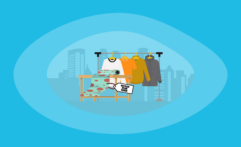10 Most Sustainable Velvet Clothing Brands: The Conscious Consumer’s Guide
Impactful Ninja is reader-supported. When you buy through links on our site, we may earn an affiliate commission.
Learn more
Learn more
.
Hey fellow impactful ninja ? You may have noticed that Impactful Ninja is all about providing helpful information to make a positive impact on the world and society. And that we love to link back to where we found all the information for each of our posts. Most of these links are informational-based for you to check out their primary sources with one click. But some of these links are so-called "affiliate links" to products that we recommend. First and foremost, because we believe that they add value to you. For example, when we wrote a post about the environmental impact of long showers, we came across an EPA recommendation to use WaterSense showerheads. So we linked to where you can find them. Or, for many of our posts, we also link to our favorite books on that topic so that you can get a much more holistic overview than one single blog post could provide. And when there is an affiliate program for these products, we sign up for it. For example, as Amazon Associates, we earn from qualifying purchases. First, and most importantly, we still only recommend products that we believe add value for you. When you buy something through one of our affiliate links, we may earn a small commission - but at no additional costs to you. And when you buy something through a link that is not an affiliate link, we won’t receive any commission but we’ll still be happy to have helped you. When we find products that we believe add value to you and the seller has an affiliate program, we sign up for it. When you buy something through one of our affiliate links, we may earn a small commission (at no extra costs to you). And at this point in time, all money is reinvested in sharing the most helpful content with you. This includes all operating costs for running this site and the content creation itself. You may have noticed by the way Impactful Ninja is operated that money is not the driving factor behind it. It is a passion project of mine and I love to share helpful information with you to make a positive impact on the world and society. However, it's a project in that I invest a lot of time and also quite some money. Eventually, my dream is to one day turn this passion project into my full-time job and provide even more helpful information. But that's still a long time to go. Stay impactful,Affiliate Disclosure
Why do we add these product links?
What do these affiliate links mean for you?
What do these affiliate links mean for us?
What does this mean for me personally?
![]()
Velvet is a type of fabric traditionally woven with silk and gradually modernized with more recently cultivated or invented fibers. Since velvet can be made from any kind of yarn, its environmental impacts are diverse and inconsistent. Also, fashion greenwashing makes it harder for you and all other consumers to figure out which velvet clothing brands offer the most eco-friendly clothes. So, we had to ask: Which are the most sustainable velvet clothing brands?
The most sustainable velvet clothing brands include Christy Dawn, blue of a kind, and ARMEDANGELS, which reutilize textile waste, reduce process emissions, and produce long-lasting garments. In addition, Whimsy + Row and Thought commit to low-impact materials and ethical practices.
Whether you are searching for an evening dress, a jacket, or a pair of pants for your wardrobe without negatively impacting the soil, the water, the animals, and other people, there is a brand for you. So, let’s keep reading to learn more about the most sustainable velvet clothing brands and how they ensure sustainable, ethical practices.
Here’s How Sustainable Silk Generally Are
Velvet fabrics are woven materials traditionally made with silk. Silk-based velvet is not sustainable as sourcing and processing silk protein fibers are resource-intensive. At the usage stage, washing and caring for velvet fabrics have high environmental impacts. However, sustainable velvet fabrics can be made from other types of yarns.
“Sustainable: The ability to be maintained at a certain rate or level | Avoidance of the depletion of natural resources in order to maintain an ecological balance”
Oxford Dictionary
To understand the sustainability of velvet, we’ve assessed the life-cycle and each stage’s sustainability. This life-cycle assessment (LCA) is a method to evaluate the environmental impacts of products and materials. Here’s a quick summary of our LCA of velvet!
What makes sustainable velvet: Upcycling velvet is sustainable as the process recirculates the velvet deadstock or surplus that would otherwise end up in landfills while bypassing the energy-intensive step of farming (bio-based velvet) or mining (synthetic velvet). Similarly, velvet made with recycled fibers, sometimes called recycled velvet, is also sustainable.
Additionally: Velvet fabrics made with organic plant materials, such as organic cotton, are also considered sustainable.
Here’s How We Selected the Most Sustainable Velvet Clothing Brands
The brands on this list were chosen based on their commitment and actions to promote sustainable practices while reducing the environmental impacts of the textile industry.
They are transparent about their materials, processes, and workforce management within their supply chain.
Some brands focus their efforts on reducing waste and optimizing natural resources while others strive to reduce the carbon footprint of their clothes.
All of these brands share the commitment to reshape the textile industry toward a more sustainable and Earth-friendly sector.
These Are the 10 Most Sustainable Velvet Clothing Brands
Most Sustainable Velvet Clothing Brands
Overall, these velvet clothing brands are sustainable. Yet, they take various approaches to reduce environmental impacts and uphold ethical standards. Let’s dive into each brand and find out more.
Christy Dawn: Vintage-Inspired Dresses Made With Deadstock and Organic Fabrics

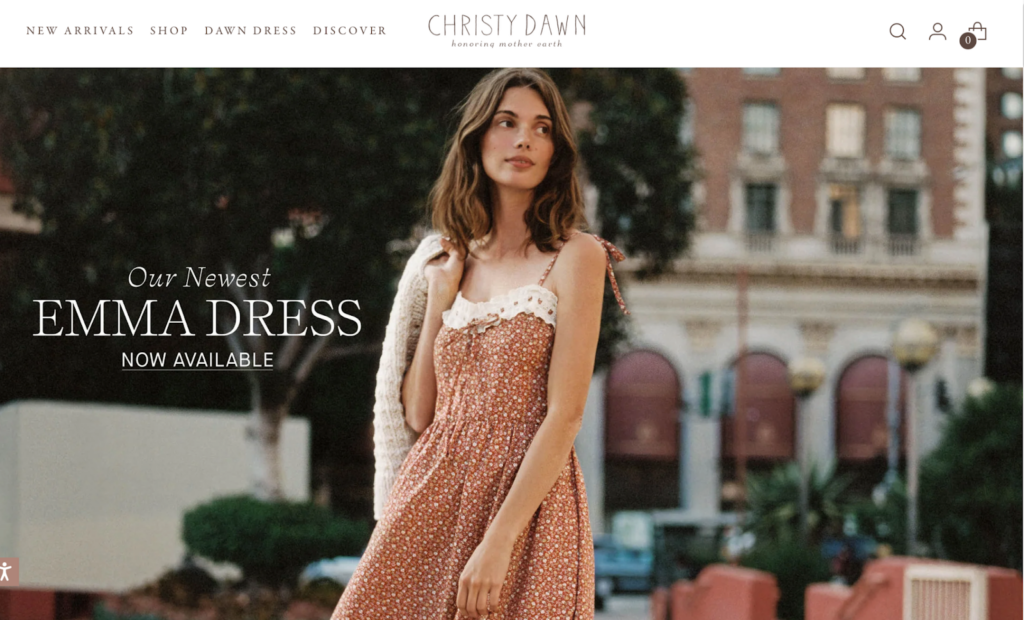
“We forge mutually beneficial relationships with all of the people and ecosystems we work with, from the farm and weavers in India to dressmakers and photographers in Los Angeles.”
Christy Dawn
🌎
How do they ensure their sustainability?
Christy Dawn ensures sustainability by sourcing eco-friendly materials, making long-lasting products, and offsetting their carbon emissions. They use a high proportion of low-impact textiles, including deadstock fabrics, organic cotton, and regenerative cotton. By diverting deadstock fabrics (velvet, wool, fleece, and leather) away from landfills and into their dresses, tops, and shoes, they lower their carbon footprint while reducing textile waste. Additionally, Christy Dawn sources cotton from a regenerative farm, harvesting the fibers and renourishing the land. The Christy Dawn × Oshadi Farm is a collaboration that increases the solid health and biodiversity of 219 acres of land and addresses climate change by drawing down more than 2 million tons of carbon from the atmosphere. Further down the life-cycle in the manufacturing stage, Christy Dawn opts for construction techniques that enable them to produce high-quality, timeless pieces that consumers can wear for a long time, reducing the impact of owning clothes. Regarding their climate impact, Christy Dawn eliminates, captures, or mitigates all of the carbon emissions created from manufacturing and shipping their products via their partnership with EcoCart. Lastly, they partner with ThreadUp to give pre-loved clothes the best possible chance at a second life, extending textile lifespans and reducing the overall environmental impacts of owning an item of clothes.
🌐
How do they ensure their ethics?
Christy Dawn traces their supply chain and ensures that some of their suppliers pay living wages.
🤝
Are they part of any giving-back programs?
Christy Dawn is not known to be part of any giving-back programs.
🛍️
What is their product range?
- Best for: womenswear
- Product range: dresses, knitwear, outerwear, jackets, tops, blouses, bottoms, loungewear, jumpsuits, overalls, shoes, plus-size accessories
- Price range: $$$
- Size range: XS–3XL
blue of a kind: Clothes Made Exclusively From Pre-Existing Garments and Repurposed Fabrics
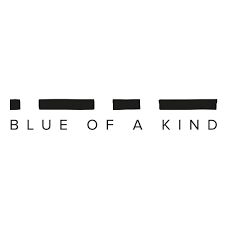
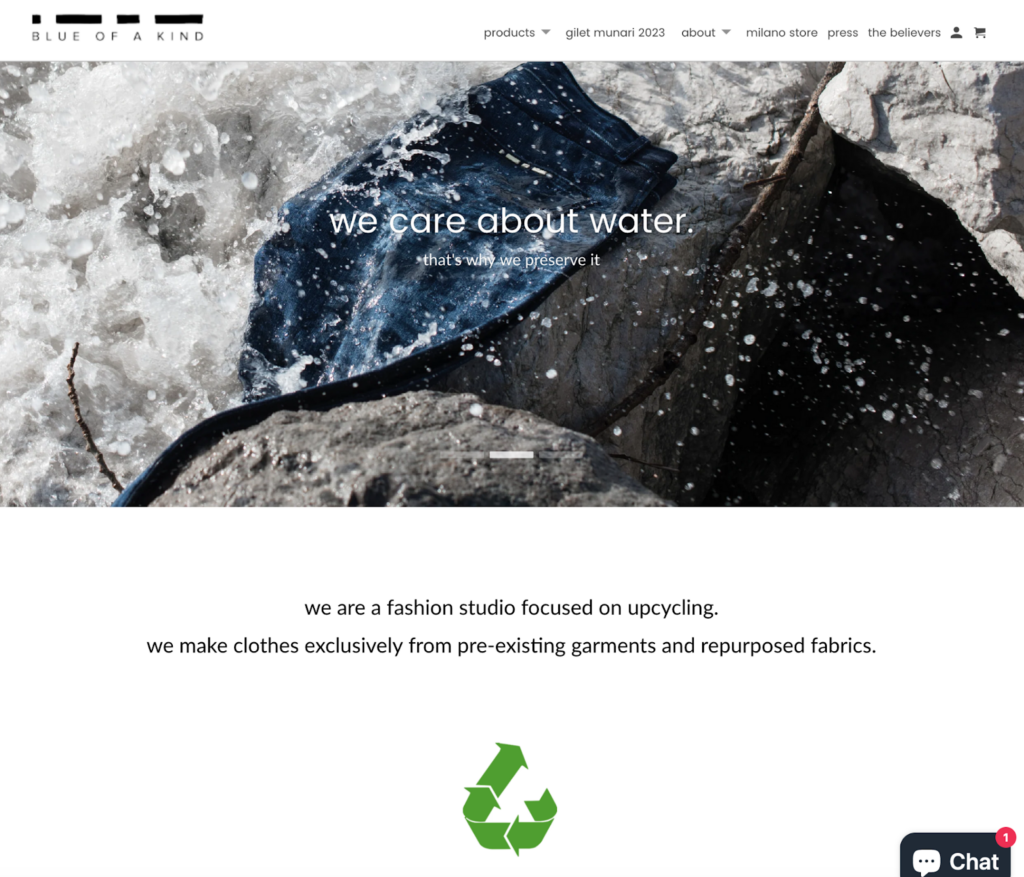
“As a brand, we felt the need to subvert industry’s habits and rules, embracing a different perspective: respecting the planet and workers’ dignity. That’s what we are.”
blue of a kind
🌎
How do they ensure their sustainability?
blue of a kind promotes sustainability by making garments with existing fabrics and garment-related elements with recycled materials. Regarding their garments, they source a high proportion of vintage jeans and deadstock fabrics (denim and cotton-based velvet). Similarly, their hang tags are made with “crush paper,” an ecological material from organic waste. blue of a kind also sources some low-impact virgin fabrics, including Fairtrade-certified organic cotton, recycled cotton, TENCELTM, and REFIBRATM for some garments and garment accessories. Beyond reducing their water footprint by repurposing leftover fabrics, blue of a kind innovates to dye their products with cotton powder obtained from pre-owned cotton garments. Such a process enables them to save as much as eight liters of water per garment. Furthermore, blue of a kind keeps their supply chain relatively centralized in Southern Europe, reducing their transporting carbon footprint. They source most of their deadstock and vintage garments in France and Italy and have the raw materials shipped to Italy, where they are handcrafted. Lastly, blue of a kind offers free repairs for life, supporting longer product lifespans and a lower environmental impact of using such products.
🌐
How do they ensure their ethics?
blue of a kind traces most of their supply chain. Their final production stage happens in Italy, a medium-risk country for labor abuse.
🤝
Are they part of any giving-back programs?
blue of a kind is not known to be part of any giving-back programs.
🛍️
What is their product range?
- Best for: womenswear, menswear
- Product range: jeans, jackets, coats, T-shirts, sweatshirts, accessories
- Price range: $$$
- Size range: XS–L
ARMEDANGELS: Sustainable Clothing Brand Plus an Agent of Lifestyle Change


“So starting out with the humble tee, we took our oath against wage slavery, chemical shortcuts, and mass-producing pure crap, and transformed ourselves into one of the first clothing brands in all the land to put people and planet first.”
ARMEDANGELS
🌎
How do they ensure their sustainability?
ARMEDANGELS ensures sustainability by reducing carbon footprints while enabling people to change lifestyles to fight climate change. The brand innovates to cut down carbon emissions in their supply chain, starting with sourcing a high proportion of eco-friendly materials. Specifically, they use GOTS-certified organic cotton fabrics, wood-based fabrics, and organic wool fabrics that meet both the Global Organic Textile Standard (GOTS) and the Responsible Wool Standard (RWS). Additionally, ARMEDANGELS chooses materials with the lowest carbon footprint possible, for example, opting for lyocell over silk or velvet made with organic cotton over velvet made with synthetic fibers while increasing recycled content, such as recycled wool and recycled cotton. For example, within a year, the share of recycled cotton in their DetoxDenim jeans increased from 5% to 37%, with some jeans in the collection containing 100% recycled cotton. DetoxDenim is their mission to create cleaner jeans by eradicating unnecessary chemicals from the production process. Lastly, ARMEDANGELS’s efforts to encourage lifestyle change include care and repair guides to keep garments longer in circulation. They also have a resale platform that facilitates traded-in to be sold again as second-hand clothes or recycled as fibers for new clothes.
🌐
How do they ensure their ethics?
ARMEDANGELS ensures their ethics by only working with trusted partners to deliver decent wages and workers’ safety. They directly and actively monitor all their suppliers and the suppliers’ nominated subcontractors via on-site and online Internal Due Diligence Check and Self-Assessment, external audits by Fair Wear Foundation (FWF), Global Organic Textile Standard and third-party audits, continuous support, and tailored training programs by third parties. ARMEDANGELS ensures payment of a living wage in part of their supply chain and pays a markup where they notice wage issues via the living wage project. Most importantly, they are fully transparent about the journey from raw material to their products, especially where people and animals are involved, and the impacts of their actions.
🤝
Are they part of any giving-back programs?
ARMEDANGELS raises funds by donating part of their sales to support various organizations and campaigns. For example, during the COVID-19 pandemic, they have raised €745.800 ($790,883.61 USD) for Doctors Without Borders, facilitating isolation wards, COVID-19 clinics, and protective clothing for medical professionals worldwide. Other fundraising projects include supporting the climate movement with German Zero and the Climate Emergency Fund, fighting for equality with UN Women, advocating for fair payment and safe working conditions for Bangladeshi garment workers with the National Garment Workers Federation, and rescuing refugees in the Mediterranean Sea with Sea-Watch.
🛍️
What is their product range?
- Best for: kidswear, menswear
- Product range: denim jeans, jackets, jumpsuits, shorts, skirts, T-shirts
- Price range: $$
- Size range: XS–XXL
Whimsy + Row: Reducing Eco-Footprint With Every Step of the Process
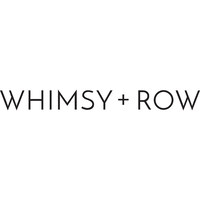
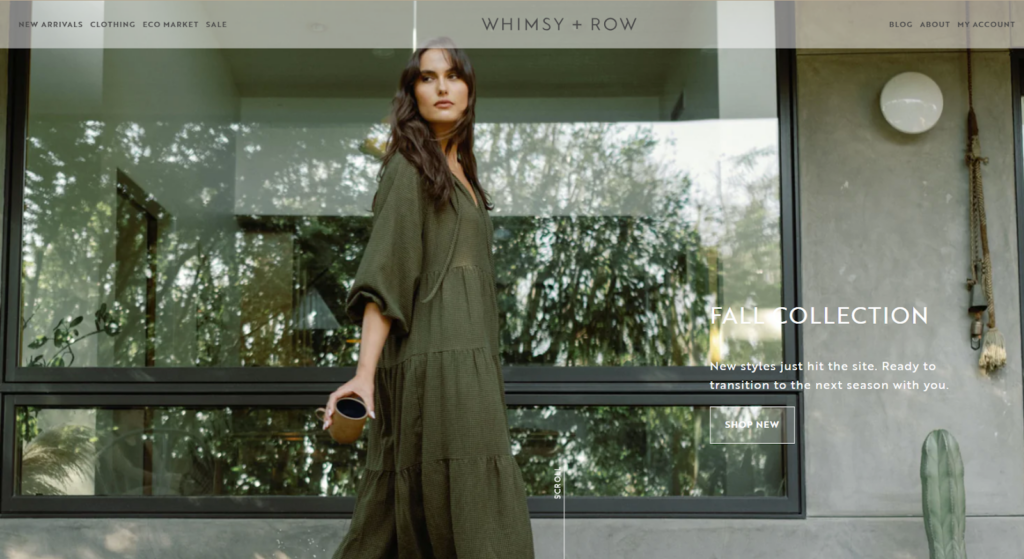
“Growing and being a good company.”
Rachel Temko, founder of Whimsy + Row
🌎
How do they ensure their sustainability?
Whimsy + Row prioritizes sustainability by opting for low-impact materials such as certified organic cotton, linen, and deadstock/upcycled fabrics. Specifically, they use upcycled velvet for tops, blazers, or hair scrunchies. Their clothes are made with low-impact dyes and recycled water. Furthermore, they reduce waste through their small-batch production of long-lasting products and efforts to close the loop to reach zero waste. The final stages of manufacturing are done locally to reduce the transportation footprint. They further offset their carbon emission with the Carbon Fund. Whimsy + Row is carbon neutral.
🌐
How do they ensure their ethics?
Whimsy + Row clothing is made within a few miles of their office, enabling weekly factory visits. The brand ensures that fair wages are given and that workers are being treated fairly.
🤝
Are they part of any giving-back programs?
Whimsy + Row actively participates in giving-back programs that support environmental causes and community initiatives. Specifically, they donate money to organizations like One Tree Planted, People Tree, Global Fund for Women, Black Lives Matter, Reclaim the Block, Black Vision Collective, Downtown Women’s Health Center, and Feeding America. Once a month, their employees also donate their time to community work, such as cleaning the beach or planting trees.
🛍️
What is their product range?
- Best for: womenswear with eco-friendly, contemporary designs
- Product range: skirts, denim, dresses, pants, tops, blouses, shorts, lingerie, plus-size
- Price range: $$$
- Size range: XS–3XL
Thought: Clothes Made With Responsibly-Sourced Materials


“We’ve sourced the most earth-kind fabrics we could find. So you don’t have to think about it.”
Thought
🌎
How do they ensure their sustainability?
Thought ensures sustainability by using eco-friendly materials and reducing textile waste. They use low-impact fabrics, such as organic cotton, hemp, plant-based semi-synthetic fabrics, and recycled fabrics. Specifically, they exclusively use organic cotton as the base for their velvet clothing items. Instead of plastic packaging, they use FSC-certified recycled paper labels and 100% corn-based, compostable paper mailing bags. They also tackle the textile waste problem by partnering with TRAID, offering pre-loved clothing a new lease of life while promoting a circular fashion economy. Lastly, they provide resources to care for and mend clothes to extend their lifespan, lowering the carbon footprint.
🌐
How do they ensure their ethics?
Thought has a Code of Conduct that covers all of the ILO Four Fundamental Freedoms principles. More and more of their garments are GOTS and Fairtrade Certified. Their ethical commitment includes upholding animal welfare.
🤝
Are they part of any giving-back programs?
Thought is not known to be part of any giving-back programs.
🛍️
What is their product range?
- Best for: womenswear, menswear, childrenswear
- Product range: shirts, skirts, denim, sweaters, scarves, dresses, pants, jackets, blazers, knitwear, tops, blouses, T-shirts, socks, stockings, tights, shorts, underwear, sneakers, jewelry, jumpsuits, playsuits
- Price range: $$
- Size range: XS–XXL
Flare Street: Vintage-Inspired, Hand-Made Velvet Clothes
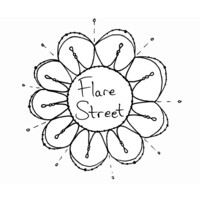
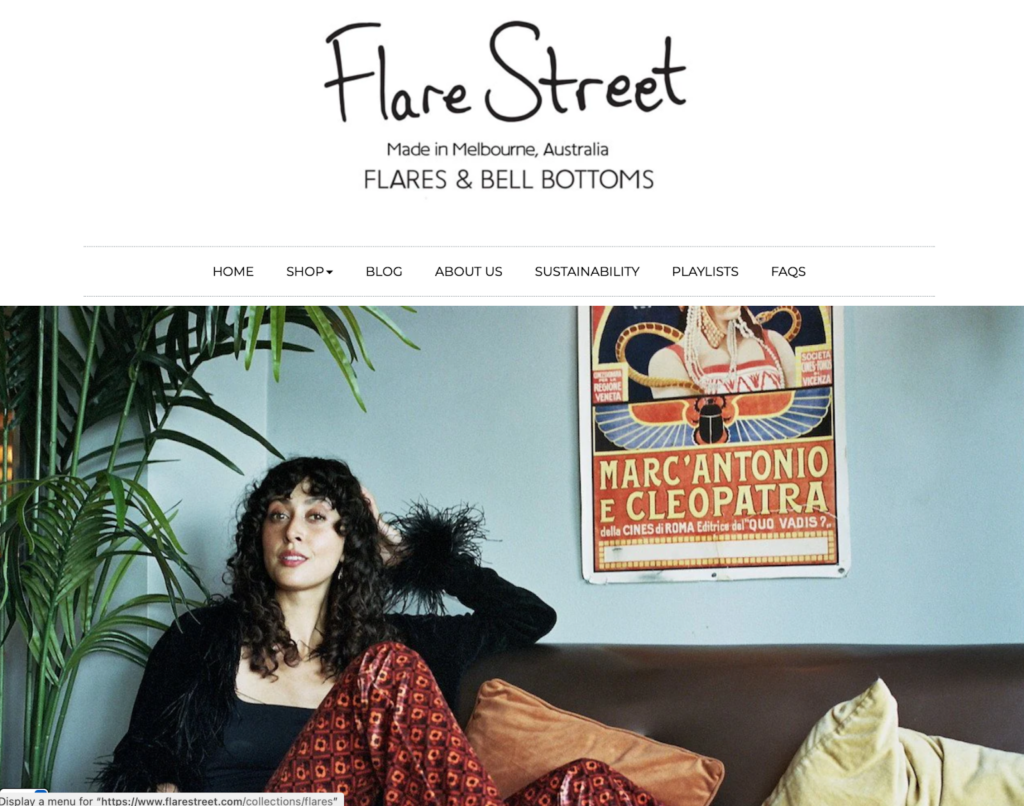
“ Focusing on buying from local and independent fabric stores is super important to our brand, we source factory ends and fabrics from local closing manufacturers to help keep the worlds waste down. ”
Flare Street
🌎
How do they ensure their sustainability?
Flare Street promotes sustainability by minimizing their climate impact and reducing textile waste. Specifically, Flare Street minimizes their climate impact by reducing and offsetting their carbon emissions. In 2019, they partnered with the Carbon Neutral Charitable Fund to offset their emissions for that year (and in the years since) by planting trees native to Australia, supporting natural ecosystems and wildlife, and creating climate-resilient habitats. In 2020, Flare Street moved to a solar-powered studio. Additionally, they use a carbon-neutral delivery service to send off their orders. Regarding waste reduction approaches, they source factory surplus and deadstock to vintage-inspired clothes, operate on limited production runs and pre-orders, and donate their offcuts to a local Melbourne company that repurposes, recycles, and re-spins this yarn to create socks, couches, etc. All the thread used in their garments is 100% recycled from discarded water bottles, while their garments are packed in 100% compostable satchels.
🌐
How do they ensure their ethics?
Flare Street traces most of their supply chain. Their key manufacturing partner is based in Australia, a low-risk country for labor abuse, pays workers a living wage, and is certified by Ethical Clothing Australia. Furthermore, Flare Street is transparent about their operation, from the designing process to the creation of their garments and the origins of their fabrics. For example, their luxury velvet fabrics come from South Korea, while their knits come from Italy.
🤝
Are they part of any giving-back programs?
Flare Street contributes to an Indigenous-controlled Naarm-based organization as part of #paytherent.
🛍️
What is their product range?
- Best for: womenswear
- Product range: tops, bottoms, catsuits
- Price range: $$
- Size range: XS–3XL
LANIUS: Premium-Quality Womenswear Advocating for Slow Fashion

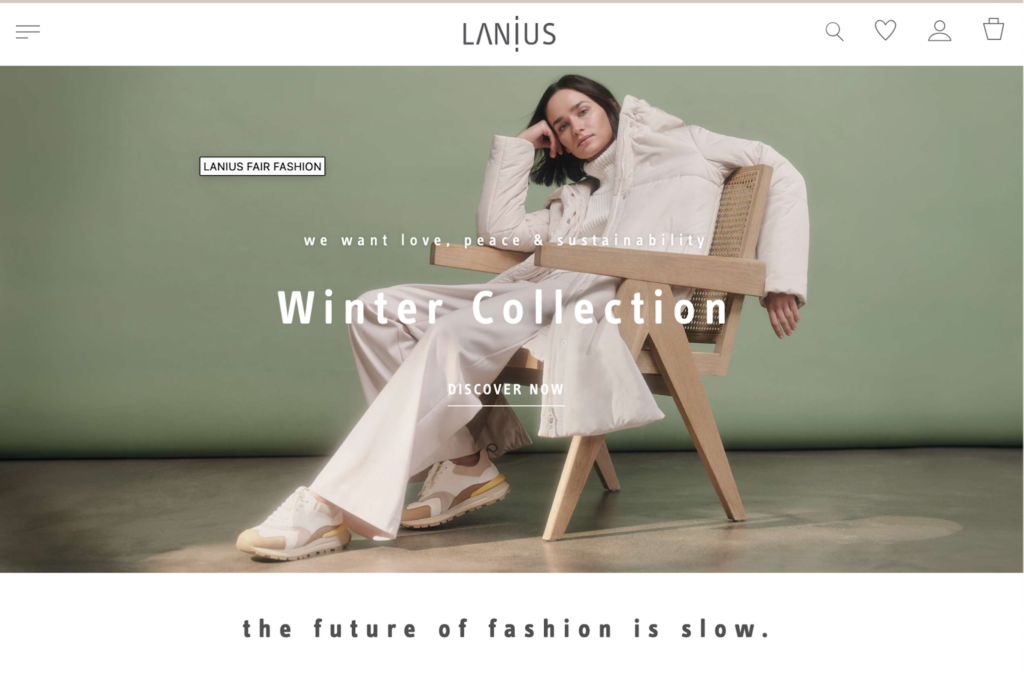
“For our textiles we use a whole variety of renewable raw materials, free of pesticides, herbicides and other poisons. ”
LANIUS
🌎
How do they ensure their sustainability?
LANIUS prioritizes sustainability by opting for a high proportion of eco-friendly materials, lowering the carbon footprint, and reducing waste by reusing some of their offcuts. They mainly use organic materials from controlled organic cultivation or from controlled organic animal husbandry, including GOTS-and OCS-certified organic cotton, hemp, linen, mulesing-free wool, and silk. Specifically, their velvet fabrics are made with GOTS-certified organic cotton, lowering the environmental impacts. Further down the life-cycle in the manufacturing stage, LANIUS uses low impact non-toxic dyes in most of their products while avoiding chemical high-grade finishing, such as anti-moth finishes, chlorine bleach or biocide finishes, resin, nickel, and Teflon. Regarding their carbon footprint, the brand implements various reduction measures like shortening the value chains to avoid unnecessary transport routes, using renewable energy in their supply chain, and shipping products in recycled cardboard boxes that are often reused several times. The unavoidable emissions are offset in reforestation and renewable energy projects in Asia. Lastly, as their dedication to slow fashion, LANIUS strives to extend the life of the clothes you and other consumers already own with their Care – Repair – Resell – Rent platform.
🌐
How do they ensure their ethics?
LANIUS traces most of their supply chain and discloses factories where their various finished products are manufactured. Their production partners have sustainability certificates such as the GOTS certificate, the BSCI Code of Conduct, and the SA8000 standard and are audited by the Fair Wear Foundation. Additionally, LANIUS regularly visits their partners.
🤝
Are they part of any giving-back programs?
LANIUS is not known to be part of any giving-back programs.
🛍️
What is their product range?
- Best for: womenswear
- Product range: shirts, denim, sweaters, pants, hoodies, tops, blouses, T-shirts
- Price range: $$
- Size range: S–XL
People of Leisure: Comfortable Everyday Wear Made in the US
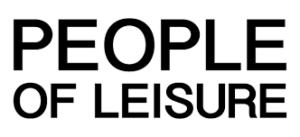
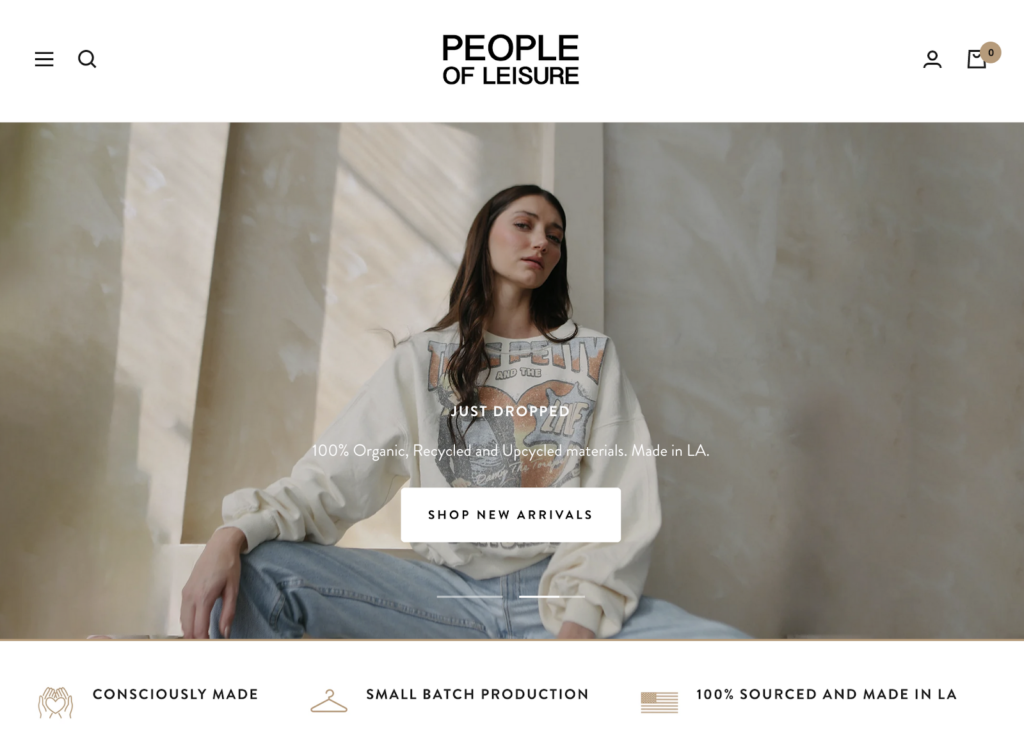
“Here at People of Leisure, we believe in a Zero Sweat policy that honors artisans by maintaining livable wages while offering responsible production practices.”
People of Leisure
🌎
How do they ensure their sustainability?
People of Leisure ensures sustainability by using low-impact textiles and dyestuff, minimizing textile waste, and manufacturing locally to reduce climate impact. They use a high proportion of organic fibers (cotton and hemp) and upcycled materials for their garments. For example, their Upcycle Travel Light Velvet Pants are made with 100% upcycled cotton-based velvet fabrics. To minimize waste and slow down overconsumption, People of Leisure operates based on small-batch clothing runs. Lastly, they manufacture locally in the US, avoiding long-distance shipping to reduce the climate impact of their garments.
🌐
How do they ensure their ethics?
People of Leisure has a Zero Sweat policy, creating an environment that honors their garment workers through livable wages and responsible production and practices. They trace part of their supply chain and visit their suppliers.
🤝
Are they part of any giving-back programs?
People of Leisure donates 10% of all online orders to Soles4Souls, a non-profit organization fighting poverty and commercial waste.
🛍️
What is their product range?
- Best for: womenswear
- Product range: shirts, denim, sweaters, dresses, pants, tops, blouses, T-shirts
- Price range: $$
- Size range: XS–XXL
Eileen Fisher: Secondhand Velvet Clothes From a Sustainable Fashion Brand
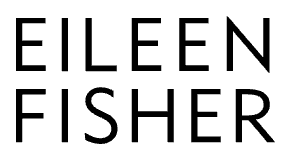
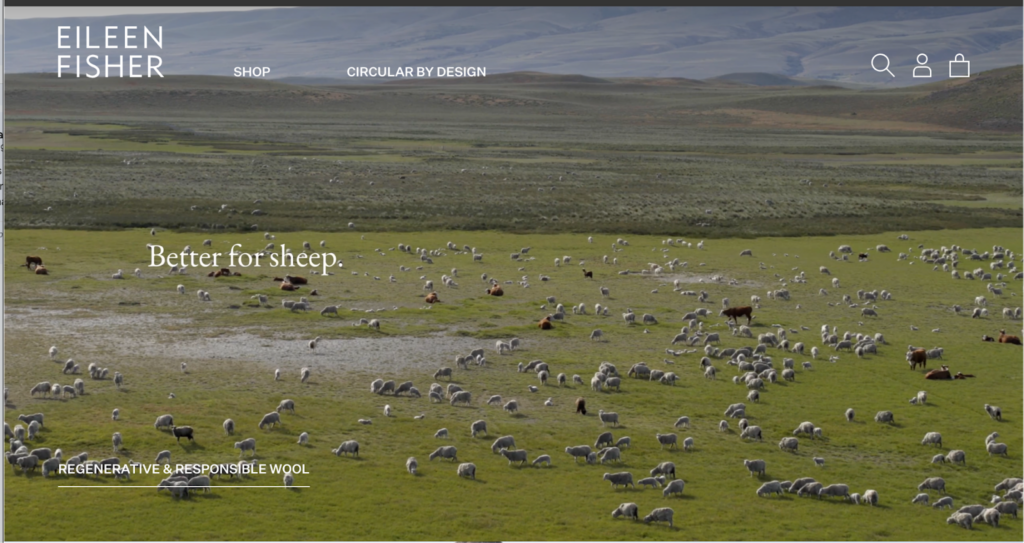
“The Biggest Thing We Can Do Is Reduce”
Eileen Fisher, founder of Eileen Fisher
🌎
How do they ensure their sustainability?
Eileen Fisher’s sustainability efforts focus on using eco-friendly materials, including recycled cotton, organic cotton, organic linen, and hemp, reducing greenhouse gas emissions generated from their operations and supply chain, reducing fabric and corporate waste, and recycling the brand’s used clothes back into new products. Their commitments to sustainable materials, circular systems, and environmentally friendly practices are demonstrated in initiatives like VISION 2020, Horizon 2030, and Renew. Specifically, you will be able to find many pre-loved velvet clothes via their take-back and resale program “Eileen Fisher Renew”. They are also certified as a B Corporation and a Bluesign® brand.
🌐
How do they ensure their ethics?
Eileen Fisher is committed to ethical practices. They have worker empowerment initiatives such as collective bargaining and the right to make a complaint. For example, their “Our Love, Peru” project supports over 450 families in and around Arequipa with higher fair trade wages and investments in the local community. Additionally, Their VISION 2020, set in 2015, tackled unethical labor practices. They also have a formal animal welfare policy aligned with Five Freedoms. Additionally, Eileen Fisher follows the Responsible Wool Standard and the Responsible Down Standard, which ensures the humane treatment of animals used for textile products.
🤝
Are they part of any giving-back programs?
Eileen Fisher supports many women-owned businesses. The brand has provided, since their inception, many grants for women, including the current program Supporting Women in Environmental Justice.
🛍️
What is their product range?
- Best for: elegant, classic, and casual women’s clothes
- Product range: dresses, blouses, sweaters, cardigans, pants, skirts and outerwear, shoes, accessories
- Price range: $$$
- Size range: XXS–3XL
Reformation: Pre-Owned Velvet Clothes From Sustainable Brand

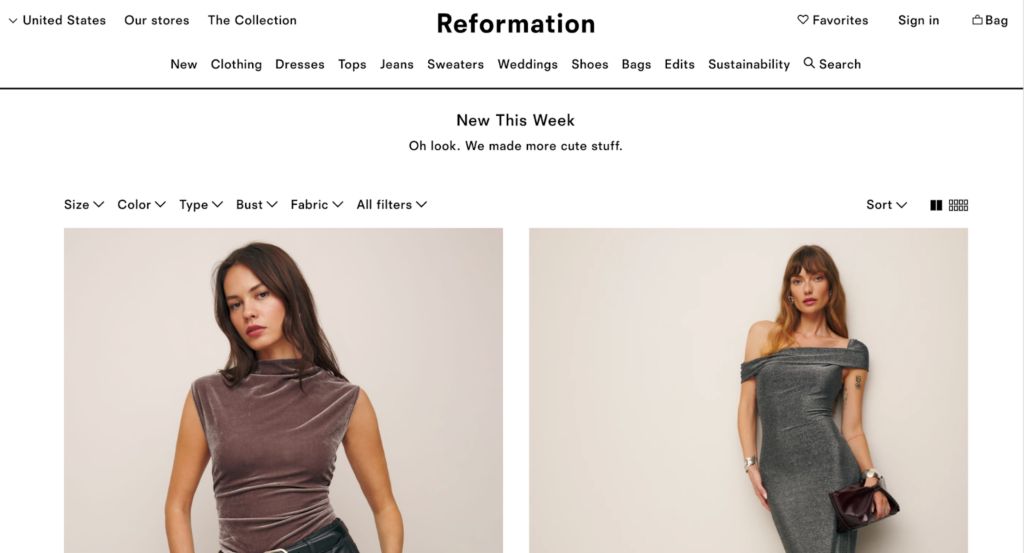
“We’re committed to pushing the industry forward and investing in future-focused solutions, which is why we’re a certified Climate Neutral company and will be Climate Positive by 2025.”
Reformation
🌎
How do they ensure their sustainability?
Reformation commits to better fabrics, intending to trade all virgin materials for recycled, regenerative, or renewable ones by 2025. Their most-preferred fabrics include recycled cotton, regenerative cotton, TENCEL™ lyocell, TENCEL™x REFIBRA™, and deadstock, accounting for 32% of all their clothes. They also use recycled cashmere and recycled wool. They commit to becoming circular by 2030 by designing out waste at every stage of production, turning any occurring production waste into new products, and using renewable and regenerative practices for necessary virgin materials. Furthermore, their RefRecycling incentive enables customers to sell their preloved Reformation clothes for store credits. Such items will be broken down into fibers and turned into new products. Additionally, you will be able to find many pre-owned Reformation velvet clothes on Vestiaire Collective. Reformation also connects their suppliers with environmental solutions such as renewable energy, water-saving technologies, energy reduction solutions, chemical input optimization, and wastewater management. Last but not least, they openly share the carbon and water footprint of each product they make, fostering transparency and accountability in the fashion industry. Reformation is Bluesign® and Climate Neutral certified.
🌐
How do they ensure their ethics?
Reformation is fully transparent about where their clothes are made and the practices in such factories. Their Supplier Code of Conduct is based on International Labor Organization (ILO) standards. Their factory list shares many details about their factories, including whether a union and a collective bargaining agreement are present and the last audit. They have aligned with the Transparency Pledge and are participating in the Open Supply Hub to expand on the details that are made public so they can be more accountable for the working conditions in their partner factories. They give workers at their vendors a voice to bring up problems regarding their working conditions, level of happiness, working hours, and wages, and collaborate with vendors to ensure necessary improvements. Reformation is also a member of the Fair Labor Association, an initiative committed to promoting fair labor standards worldwide.
🤝
Are they part of any giving-back programs?
Reformation is not known to be part of any giving-back programs.
🛍️
What is their product range?
- Best for: womenswear
- Product range: dresses, tops, bodysuits, denim, cardigans, sweaters, wedding dresses, shoes
- Price range: $$$
- Size range: XS–XL
Velvet Fabrics: Soft and Luxurious Textile Materials Traditionally Made with Silk
Velvet fabrics are woven materials originally made with silk, possessing soft, plush, and luxurious properties. Modern velvet fabrics can be made with any fiber, natural or synthetic.
Here are the life-cycle stages of velvet fabrics and each stage’s sustainability assessment:
- Sourcing plant- and animal-derived materials for making velvet fabrics: Sourcing silk as raw material for velvet fabrics is not sustainable. Silk comes from the cocoons that silkworm caterpillars produce to wrap around themselves while transforming into silkworm moths. The main food for these larvae is the mulberry tree leaves, which are often cultivated with significant land, irrigation, and (unnecessary) synthetic agrochemicals. However, the sourcing stage of velvet fabrics can be sustainable when raw materials come from recycled waste, organically farmed and/or low-input plants, and fast-growing trees. For example, sourcing discarded cotton fibers (recycled cotton), organic flax plants (organic linen), or eucalyptus wood (lyocell) as raw materials for velvet fabrics is sustainable.
- Manufacturing of velvet fabrics: Manufacturing velvet fabrics is reasonably sustainable. The processes in velvet manufacturing are fundamentally mechanical, regardless of which base textile is used. The type of process dyes and the associated environmental impacts vary depending on the base textile.
- Transportation of velvet fabrics: Transporting can be a carbon-intensive life-cycle stage for clothing items made with velvet fabrics due to the distances covered and emissions associated with transporting vehicles. Velvet fabrics typically travel from fields (plant-based virgin velvet) or collection hubs (recycled velvet fabrics) to processing and finishing factories, sorting centers, shops, and consumers’ homes before going to recycling centers or landfills.
- Usage of velvet fabrics: The sustainability of using velvet fabrics depends on the yarn(s) used in manufacturing. Using velvet fabrics made with plastic-based yarns like petroleum-derived polyester or nylon is unsustainable. These materials release microplastics into marine environments. This doesn’t happen with bio-based yarns, such as linen or lyocell, leading to a more sustainable usage stage for bio-based velvet fabrics.
- End-of-life of velvet fabrics: The sustainability of velvet fabrics’ end-of-life stage depends on the yarn(s) used in manufacturing. The end-of-life of velvet fabrics made with plastic-based synthetic yarns like petroleum-derived polyester or nylon is not sustainable. These materials are also not biodegradable. The end-of-life of velvet fabrics made with bio-based yarns, however, is generally sustainable. Because of their biodegradability, these materials can be disposed of by composting, incinerating, and landfilling.
The sustainability of velvet fabrics depends largely on the type of fibers or fiber blends used. The most sustainable velvet fabrics are made with renewable, organically-cultivated plant fibers like organic cotton. Alternatively, upcycled and recycled velvet fabrics are also sustainable because they are products of utilizing waste, bypassing the resource-demanding farming or mining stage (for synthetic velvet).
Why Is It Important to Buy Products Made of More Sustainable Fabrics
It is important to buy products made from more sustainable fabrics because a sustainable textile industry has a lower carbon footprint, helps save natural resources, and is better for forests, animals, and humans alike.
Buying Sustainable Fabrics Reduces Your Carbon Footprint
The production of clothing and footwear is estimated to contribute 10% of global greenhouse gas emissions—more than all international flights and shipping combined. If the fashion industry were a country, it would be the fourth largest emitter of carbon dioxide.
One way to reduce the carbon footprint of the clothes you buy is to opt for sustainable fabrics. Sustainable fabrics, which are often made with natural or recycled fibers, have relatively low carbon footprints compared to petroleum-based fabrics. For example, organic cotton made in the US has a carbon footprint of 2.35 kg CO2 (per ton of spun fiber)—a quarter of polyester’s carbon footprint.
Buying Sustainable Fabrics Reduces Demand for Natural Resources and Waste Management
The textile industry uses water and land to grow cotton and other fibers. It is estimated that 79 billion cubic meters of water were used for the sector worldwide in 2015. For example, producing a single cotton T-shirt requires as much water as one person drinks for 2.5 years (2,700 liters of fresh water).
Worse yet, the textile economy is vastly more linear than circular: the largest amount of resources used in clothes ended up in landfills (instead of being recycled to remake clothes). According to a report by the Ellen MacArthur Foundation,
- Less than 3% of materials used in the textile economy in 2015 came from recycled sources.
- In other words, more than 97% of resources used in making clothes are newly extracted.
When clothing items are disposed of within a short period of time—under a year in the case of half of the fast fashion clothes—the natural systems that provide raw materials for fabrics don’t have enough time to recover and regenerate, which could lead to ecological breakdown.
Sustainable fabrics are made with less water and emissions while lasting longer:
- Because they are durable, you don’t need to buy new clothes too often.
- Thus, you help reduce the pressure to extract more resources for making new items.
Similarly, making and consuming sustainable fabrics made with recycled materials reduces the demand for virgin materials while helping tackle waste management.
Buying Sustainable Fabrics Encourages Sustainable Management of Forests
Sustainable plant-based fabrics are made with raw materials from forests and plantations that are sustainably managed, such as complying with FSC standards.
When you buy sustainable plant-based fabrics, you discourage unsustainable forestry practices like illegal logging. You can help reduce deforestation, biodiversity loss, and the effects of climate change.
Buying Sustainable Fabrics Encourages Fairer Treatment of Animals
The fashion industry is rife with animal mistreatment when it comes to making animal-based fabrics like wool or velvet. Every year, billions of animals suffer and die for clothing and accessories.
Buying sustainable vegan alternatives can help to reduce the pressure on raising more and more animals to meet the demand for animal-based fabrics while sacrificing their well-being and lives.
Suppose you have to buy fabrics made with, for example, wool or velvet; make sure you only choose brands committed to cruelty-free products. In that case, you help advocate better treatments for animals raised within the textile industry.
Using Sustainable Fabrics Encourages Fairer Treatment of Textile Workers
Recent statistics from UNICEF estimated as many as 170 million child laborers worldwide, many of whom were engaged in some form of work in the textile industry. They don’t get paid minimum wages and often work long hours.
When you buy sustainable fabrics from brands transparent about the working conditions at their factories, you discourage the use of child labor and help promote better working conditions for textile workers.
How Can You Generally Buy More Sustainable Fabrics
The key to sustainably buying fabrics is to check on relevant environmental and original certifications.
For natural fabrics:
- Global Organic Textile Standard (GOTS): A globally recognized certification system that ensures a certain threshold of organic content has been met. It covers manufacturing, packaging, labeling, transportation, and distribution (but not what happens in the fields where crops are grown).
- USDA Certified Biobased Product: The USDA BioPreferred® Certification is a voluntary certification offered by the United States Department of Agriculture. The certification identifies products made from plants or other renewable materials.
- Ecolabel: Ecolabel is the official European Union voluntary label recognized worldwide for certified products with a guaranteed, independently verified low environmental impact. The label requires high environmental standards throughout the entire life-cycle: from raw material extraction through production and distribution to disposal. It also encourages companies to develop innovative, durable, easy-to-repair, and recyclable products.
For plant-based semi-natural/semi-synthetic fabrics:
- Forest Stewardship Council: An FSC certification ensures that the wood (or wood-like material) comes from responsibly managed forests that provide environmental, social, and economic benefits.
There are two types of FSC Certification:- FSC Forest Management Certification, with a focus on the origin of the wood—the forest.
- FSC Chain of Custody Certification, which focuses on the path from the forest to the customer’s home.
- Program for Endorsement of Forest Certification: PEFC’s approaches to sustainable forest management are in line with protecting the forests globally and locally and making the certificate work for everyone. Getting a PEFC certification is strict enough to ensure the sustainable management of a forest is socially just, ecologically sound, and economically viable but attainable not only by big but small forest owners.
For recycled fabrics:
- Recycled Claim Standard (RCS): The Textile Exchange RCS was originally developed as an international, voluntary standard that sets requirements for third-party certification of Recycled input and chain of custody.
- Global Recycled Standard (GRS): The Global Recycled Standard (GRS) is an international, voluntary, full product standard that sets requirements for third-party certification of Recycled Content, chain of custody, social and environmental practices, and chemical restrictions. It can be used for any product with more than 20% recycled material.
For all types of fabrics:
- STeP by OEKO-TEX®: STeP by OEKO-TEX® is an independent certification system for brands, retailers, and manufacturers from the textile and leather industry. It communicates organizational environmental measures, including reducing carbon footprint and water usage.
- OEKO-TEX® Standard 100: OEKO-TEX® labels aim to ensure that products pose no risk to human health (i.e. containing banned chemicals).
Some certifications that are signaling brands’ efforts toward lowered environmental impacts and a circular economy are:
- B Corp Certification: The label B Corp is a certification reserved for for-profit companies. Certified holders are assessed on their social and environmental impacts.
- Cradle2Cradle certification: Cradle2Cradle provides a standardized approach to material circularity. It assesses whether products have been suitably designed and made with the circular economy in mind covering five critical categories: material health, material reuse, renewable energy and carbon management, water stewardship, and social fairness.
Final Thoughts
Traditional silk-based velvet fabrics are generally not sustainable. Mulberry cultivation for rearing silkworm moths is resource-intensive, using a lot of land, freshwater, and energy. Plus, many farmers use pesticides and fertilizers unnecessarily. Similarly, velvet fabrics made with plastic-based synthetic fibers, such as virgin nylon and virgin polyester, or chemical-intensive semi-synthetic fibers, such as viscose and cuprammonium rayon, are not sustainable. However, alternative yarns can be made into sustainable velvet fabrics. They include but are not limited to organic cotton, recycled polyester, or lyocell.
By purchasing new or pre-loved velvet clothes made with organically cultivated plant fibers or with recycled materials from brands that commit to sustainability, you support their mission to create a fairer and less harmful textile industry for all lives on Earth.
Here is the list (again) of the most sustainable velvet clothing brands:
- Christy Dawn
- blue of a kind
- ARMEDANGELS
- Whimsy + Row
- Thought
- Flare Street
- LANIUS
- People of Leisure
- Eileen Fisher (Pre-Owned)
- Reformation (Pre-Owned)
To make your use of these fabrics even more sustainable, follow these steps:
- Buy second-hand, recycled, or upcycled clothes made with velvet clothes.
- While using velvet clothes, maximize the number of wears between washes and keep them as long as possible.
- At the end-of-life of your velvet clothes, upcycle the materials to extend their usage and arrange for them to be recycled or properly disposed of.
Stay impactful,

Sources
- Impactful Ninja: How Sustainable Are Velvet Fabrics? A Life-Cycle Assessment
- Impactful Ninja: How Sustainable Are Silk Fabrics? A Life-Cycle Assessment
- Science Direct: Life-cycle assessment (LCA)
- Impactful Ninja: How Sustainable Are Organic Cotton Fabrics? A Life-Cycle Analysis
- Christy Dawn: Home
- blue of a kind: Home
- ARMEDANGELS: Home
- Whimsy + Row: Home
- Thought: Home
- Flare Street: Home
- LANIUS: Home
- People of Leisure: Home
- Eileen Fisher: Home
- Reformation: Home
- Good On You: Brand Directory | Christy Dawn
- Christy Dawn: Deadstock – Why We Use It
- Impactful Ninja: How Sustainable Are Wool Fabrics? A Life-Cycle Analysis
- Impactful Ninja: How Sustainable Are Leather Fabrics? A Life-Cycle Analysis
- Christy Dawn: Welcome to the Regenerative Evolution
- Christy Dawn: Honoring Mother Earth
- EcoCart: Home
- ThreadUp: Christy Dawn
- blue of a kind: Sustainability
- Good On You: Brand Directory | blue of a kind
- Impactful Ninja: How Sustainable Are Denim Fabrics? A Life-Cycle Analysis
- Impactful Ninja: How Sustainable Are Cotton Fabrics? A Life-Cycle Analysis
- blue of a kind: Free repairs for life
- Fairtrade International: Home
- Impactful Ninja: How Sustainable Are Recycled Cotton Fabrics? A Life-Cycle Analysis
- Impactful Ninja: How Sustainable Are TENCEL Fabrics? A Life-Cycle Analysis
- Lenzing: RefibraTM
- Good On You: Brand Directory | ARMEDANGELS
- Global Organic Textile Standard (GOTS): Home
- Impactful Ninja: How Sustainable Are Wood-Based Fabrics? A Life-Cycle Analysis
- Impactful Ninja: How Sustainable Are Organic Wool Fabrics? A Life-Cycle Analysis
- Textile Exchange: Responsible Wool Standard
- ARMEDANGELS: THE JOURNEY FROM RAW MATERIAL TO PRODUCT | Recycling
- ARMEDANGELS: About Us
- Impactful Ninja: How Sustainable Are Lyocell Fabrics? A Life-Cycle Analysis
- Impactful Ninja: How Sustainable Are Silk Fabrics? A Life-Cycle Analysis
- ARMEDANGELS: RETURN YOUR OLD CLOTHES | RECYCLING WITH BENEFITS
- ARMEDANGELS: DETOX DENIM
- ARMEDANGELS: Care Guide
- ARMEDANGELS: Repair Guide
- ARMEDANGELS: ACTION REPORT 2021
- Fair Wear Foundation: Home
- ARMEDANGELS: LIVING WAGE PROJECT
- ARMEDANGELS: Collaborations
- Doctors Without Borders: Home
- German Zero: Home
- Climate Emergency Fund: Home
- Sea Watch: Home
- Impactful Ninja: How Sustainable Are Linen Fabrics? A Life-Cycle Analysis
- Whimsy + Row: ABOUT OUR FABRIC
- Whimsy + Row: Upcycled Velvet
- Whimsy + Row: Matilda Top
- Whimsy + Row: Black velvet blazer
- Whimsy + Row: Velvet hair scrunchies
- Whimsy + Row: OUR VALUES & SUSTAINABILITY
- Good On You: Brand Directory | Whimsy + Row
- Whimsy + Row: OUR STORY
- Carbon Fund: Home
- One Tree Planted: Home
- Black Lives Matter: Home
- Feeding America: Home
- Impactful Ninja: How Sustainable Are Semi-Natural/ Semi-Synthetic Fabrics Fabrics? A Life-Cycle Analysis
- Impactful Ninja: How Sustainable Are Recycled Fabrics? A Life-Cycle Analysis
- Thought: Search Results | Velvet
- Thought: Zero plastic packaging
- Thought: Thought x TRAID
- Thought: Aftercare
- Good On You: Brand Directory | Thought
- Thought: Responsible Sourcing
- Good On You: Brand Directory | Flare Street
- Carbon Neutral Charitable Fund: Carbon Positive Australia
- Flare Street: Our Ethos and Sustainability
- Ethical Clothing Australia: Home
- Flare Street: DAY 4: FIND OUT MORE ABOUT THE FLARE STREET DESIGN PROCESS
- Flare Street: The creation of Flare Street pieces!
- Flare Street: DAY 3: FASHION REVOLUTION WEEK – WE’RE SHINING THE LIGHT ON OUR FLARE STREET SUPPLIERS
- We are Djirra: Home
- Good On You: Brand Directory | LANIUS
- LANIUS: Our Standards | Sustainability at every level
- LANIUS: Cotton
- LANIUS: Hemp
- LANIUS: Linen
- LANIUS: Merino wool
- LANIUS: Silk
- LANIUS: CO2 Compensation
- Climate Partner: 7017
- LANIUS: Care – Repair – Resell – Rent
- LANIUS: Fair Production
- AMFORI: BSCI
- People of Leisure: Our Responsibility
- Good On You: Brand Directory | People of Leisure
- Impactful Ninja: How Sustainable Are Hemp Fabrics? A Life-Cycle Analysis
- People of Leisure: Upcycle Travel Light Velvet Pants
- People of Leisure: Our Values
- People of Leisure: Behind This Label: The Backstory of People of Leisure
- Soles4Souls: Home
- Eileen Fisher RENEW: Home
- Eileen Fisher RENEW: Silk and Velvet
- Eileen Fisher: OUR VISION2020 RESULTS
- Eileen Fisher: Our Brand
- B Corporation: Eileen Fisher
- Good On You: Brand Directory | Eileen Fisher
- Eileen Fisher: Community | Love, Peru. Our Fair Trade Project.
- CFDA: HOW EILEEN FISHER IS THE ULTIMATE SUSTAINABLE LABEL
- Seek Capital: 11 Small Business Grants For Women
- Impactful Ninja: How Sustainable Are TENCELTM Fabrics? A Life-Cycle Analysis
- TencelTM: TENCEL™ x REFIBRA™ technology
- Reformation: Circularity
- Reformation: RefRecycling
- Vestiaire Collective: Reformation velvet
- Reformation: What is RefScale
- CLIMATE NEUTRAL: Reformation
- The Reformation: Supplier Code of Conduct
- International Labor Organization (ILO): Home
- Reformation: Supplier Code of Conduct
- Reformation: Factories
- Transparency Pledge: Home
- Open Supply Hub: Home
- Fair Labor Association: Home
- European Parliament: The impact of textile production and waste on the environment (infographic)
- Science Direct: The challenge of “Depeche Mode” in the fashion industry – Does the industry have the capacity to become sustainable through circular economic principles, a scoping review
- Science Direct: Carbon Footprint of Textile and Clothing Products
- European Parliament: Environmental impact of the textile and clothing industry
- European Parliament: What if fashion were good for the planet?
- Ellen MacArthur Foundation: A New Textiles Economy: Redesigning fashion’s future
- McKinsey: Style that’s sustainable: A new fast-fashion formula
- Forest Stewardship Council: Home
- Our World in Data: Deforestation and Forest Loss
- Our World in Data: Renewable Energy
- Peta: Animals Used For Clothing
- The Guardian: Child labour in the fashion supply chain
- Impactful Ninja: How Sustainable Are Natural Fabrics? A Life-Cycle Analysis
- BioPreferred: WHAT IS THE BIOPREFERRED PROGRAM?
- European Commission: Environment | EU Ecolabel
- Impactful Ninja: How Sustainable Are Semi-Natural/ Semi-Synthetic Fabrics? A Life-Cycle Analysis
- Forest Stewardship Council
- FSC Forest Management Certification
- FSC Chain of Custody Certification
- Program for Endorsement of Forest Certification
- Impactful Ninja: How Sustainable Are Synthetic Fabrics? A Life-Cycle Analysis
- Textile Exchange: Recycled Claim Standard (RCS)
- Textile Exchange: Global Recycled Standard (GRS)
- OEKO-TEX: Standard 100 by OEKO-TEX®
- OEKO-TEX: Certification according to STeP by OEKO-TEX®
- B Corp Certification: Home
- C2CCertified: Home
- Impactful Ninja: How Sustainable Are Nylon Fabrics? A Life-Cycle Analysis
- Impactful Ninja: How Sustainable Are Polyester Fabrics? A Life-Cycle Analysis
- Impactful Ninja: How Sustainable Are Viscose Fabrics? A Life-Cycle Analysis
- Impactful Ninja: How Sustainable Are Cupro Fabrics? A Life-Cycle Analysis


